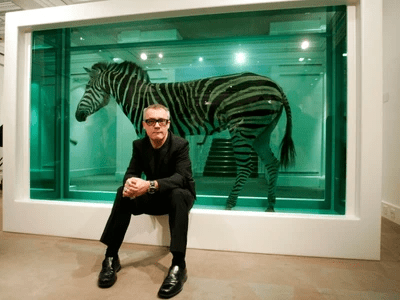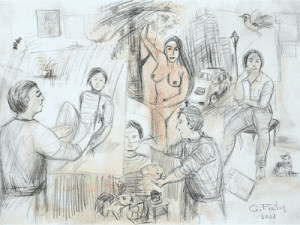Damien Hirst is a controversial modern British artist who was born on June 7, 1965. He is most known for being a part of the Young British Artists, a group that shook up the art world in the United Kingdom in the 1990s. Some of Hirst’s most well-known pieces are formaldehyde-preserved dead animals.

Damien Hirst (born Damien Steven Brennan) is an English artist who was born in Bristol and raised in Leeds. His mother subsequently characterised him as a morbid youngster who was fascinated by images of sickness and damage that were horrific and horrible. These themes will subsequently inspire some of the artist’s most well-known works.
Hirst had a number of run-ins with the authorities, including two shoplifting charges. He struggled in many other areas in school, but he excelled in art and sketching. Damien studied art at Goldsmiths, University of London, in the late 1980s, after attending the Jacob Kramer School of Art in Leeds.
Damien Hirst created an independent student show named Freeze in an empty London Port Authority facility in 1988, when he was in his second year at Goldsmiths. It was the first major event organised by the Young British Artists, who would later become known as the Young British Artists. Two of Hirst’s signature spot paintings were included in the final edition of the exhibition: multicoloured dots on white or near-white backgrounds created by hand using glossy home paint.
At and Out of Love, Damien Hirst’s first solo show, took held in an empty store on Woodstock Street in downtown London in 1991. During same year, he met Charles Saatchi, an Iraqi-British businessman who became a major supporter.

Saatchi promised to sponsor whatever work of art that Hirst desired. “The Physical Impossibility of Death in the Mind of Someone Living.” was the outcome. It consisted of a formaldehyde-preserved shark in a tank. The painting was shown at the Saatchi Gallery in 1992 as part of one of the inaugural Young British Artists exhibits. Hirst was nominated for the Turner Prize for exceptional young artists in the United Kingdom as a result of the piece’s media exposure, however he lost to Grenville Davey. “Mother and Child Divided.” Hirst’s first significant international piece, premiered at the Venice Biennale in 1993. A cow and a calf were split into pieces and displayed in different tanks as part of the project. Hirst showed a similar piece the next year, “Away from the Flock,” which included a sheep preserved in formaldehyde. During the show, Mark Bridger came into the gallery and poured black ink into the tank, then gave the piece a new title: “Black Sheep.” Bridger was charged, but his sentence was reduced to two years of probation at Hirst’s request.
Damien Hirst won the Turner Prize in 1995. He performed solo concerts in Seoul, London, and Salzburg in the second part of the decade. He also began creating music videos and short films, as well as forming the band Fat Les with actor Keith Allen and Blur’s Alex James. By the conclusion of the decade, the Young British Artists, which included Hirst, had established themselves as an important element of the UK’s mainstream art scene.

Hirst issued a statement on September 10, 2002, the day before the one-year anniversary of the terrorist attacks on the World Trade Center in New York City, characterising the assaults as “kind of like an artwork in its own right.” The anger was swift and ferocious. He apologised publicly a week later.
Damien Hirst became strong friends with Joe Strummer of the band The Clash after meeting him in 1995. Strummer died after a heart attack in late 2002. It had a significant effect on Hirst, who said, “It was the first time I felt mortal.”
Hirst showed 30 paintings at the Gagosian Gallery in New York in March 2005. They took more than three years to complete and were based on pictures primarily taken by assistants but finalised by Hirst. He debuted the piece “A Thousand Years (1990).” in 2006. It shows maggots hatching in a box, changing into flies, then feasting on a gory, severed cow’s head in a glass exhibition case. In the instance, there were buzzing live flies, several of which were electrocuted in an insect repellent apparatus. A month before his death, the renowned artist Francis Bacon commended “A Thousand Years (1990)” in a letter to a friend.
Hirst exhibited “For the Love of God,” a platinum replica of a human skull encrusted with approximately 8,600 diamonds, in 2007. The teeth are the only component of the original cranium that has been preserved. The total cost of the project was $100,000,000. It was not acquired during the first show, but it was purchased in August 2008 by a group that included Hirst himself.
Damien Hirst has been praised for igniting fresh interest in the arts with his celebrity image and theatrical sensibility. He was instrumental in restoring the worldwide reputation of the British art scene.
Hirst’s defenders, including his patron Saatchi and a slew of other well-known artists, argue that he is a showman, but that capturing the public’s attention is crucial. He is frequently cited with Andy Warhol and Jackson Pollock, two 20th-century masterpieces.
Detractors, on the other hand, dispute whether dead, preserved creatures are aesthetic. Hirst’s work, according to Brian Sewell of the Evening Standard, “is no more interesting than a stuffed pike over a pub door.”
Hirst’s No Love Lost display, which exhibited his works in 2009, earned virtually unanimous acclaim. “shockingly bad.” was how his attempts were described.

Information Citations
En.wikipedia.org, https://en.wikipedia.org/.
Recommend0 recommendationsPublished in Artists







Responses